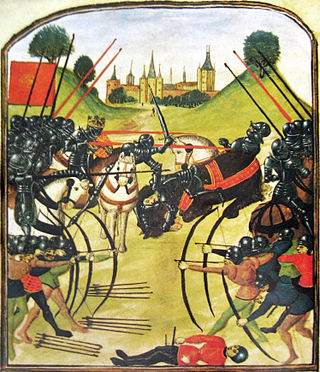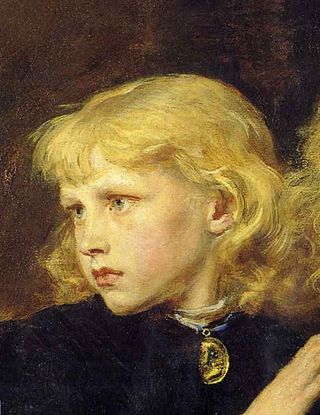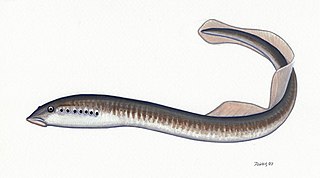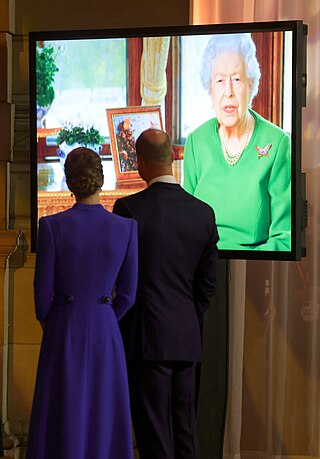
John Morton was an English cleric, civil lawyer and administrator during the period of the Wars of the Roses. He entered royal service under Henry VI and was a trusted councillor under Edward IV and Henry VII. Edward IV made him Bishop of Ely and under Henry VII he became Lord Chancellor, Archbishop of Canterbury and a cardinal.

Henry VI was King of England from 1422 to 1461 and again from 1470 to 1471, and disputed King of France from 1422 to 1453. The only child of Henry V, he succeeded to the English throne upon his father's death, at the age of nine months; and succeeded to the French throne on the death of his maternal grandfather, Charles VI, shortly afterwards.

The Battle of Tewkesbury, which took place on 4 May 1471, was one of the most decisive battles of the Wars of the Roses in England.

Lady Margaret Beaufort was a major figure in the Wars of the Roses of the late fifteenth century, and mother of King Henry VII of England, the first Tudor monarch.

A pie is a baked dish which is usually made of a pastry dough casing that contains a filling of various sweet or savoury ingredients. Sweet pies may be filled with fruit, nuts, fruit preserves, brown sugar, sweetened vegetables, or with thicker fillings based on eggs and dairy. Savoury pies may be filled with meat, eggs and cheese or a mixture of meat and vegetables.

Roe, or hard roe, is the fully ripe internal egg masses in the ovaries, or the released external egg masses, of fish and certain marine animals such as shrimp, scallop, sea urchins and squid. As a seafood, roe is used both as a cooked ingredient in many dishes, and as a raw ingredient for delicacies such as caviar.

Richard of Shrewsbury, Duke of York, was the sixth child and second son of King Edward IV of England and Elizabeth Woodville, born in Shrewsbury. Richard and his older brother, who briefly reigned as King Edward V of England, mysteriously disappeared shortly after their uncle Richard III became king in 1483.

The Crown Jewels of the United Kingdom, originally the Crown Jewels of England, are a collection of royal ceremonial objects kept in the Jewel House at the Tower of London, which include the coronation regalia and vestments worn by British monarchs.

Aust is a small village in South Gloucestershire, England, about 10 miles (16 km) north of Bristol and about 28 miles (45 km) south west of Gloucester. It is located on the eastern side of the Severn estuary, close to the eastern end of the Severn Bridge which carries the M48 motorway. The village has a chapel, a church and a public house. There is a large area of farmland on the river bank, which is sometimes flooded due to the high tidal range of the Severn. Aust Cliff, above the Severn, is located about 0.5 miles (0.80 km) from the village. The civil parish of Aust includes the villages of Elberton and Littleton-upon-Severn.

The sea lamprey is a parasitic lamprey native to the Northern Hemisphere. It is sometimes referred to as the "vampire fish". In its original habitats, the sea lamprey coevolved with its hosts, and those hosts evolved a measure of resistance to the sea lampreys.

Arlingham is a village and civil parish in the Stroud District of Gloucestershire, England. The 2021 Census recorded a parish population of 533. The parish contains the hamlets of Milton End, Overton and Priding. The next parish to the east is Fretherne with Saul.

The pouched lamprey, also known as the piharau in the North Island, korokoro,kanakana in the South Island, or wide-mouthed lamprey, is a species in the genus Geotria, which is the only genus in the family Geotriidae. The second species in the genus is the Argentinian lamprey, which was revalidated as a separate species in 2020. The pouched lamprey is native to the southern hemisphere. It spends the early part of its life in fresh water, migrating to the sea as an adult, and returning to fresh water to spawn and die.

Eudontomyzon is a genus of lamprey in the family Petromyzontidae. Most species are found in Eastern Europe.

The lake lamprey, Entosphenus macrostomus, also known as the Vancouver lamprey or Cowichan lamprey, a recent derivative of the Pacific lamprey, is a species of freshwater lamprey endemic to two North American lakes: Lake Cowichan and Mesachie Lake in Vancouver Island, Canada. The lamprey was originally called the Vancouver Island lamprey, until an error in filing shortened it to the Vancouver lamprey. The alternate common name of "Cowichan lamprey" was coined and promoted by the species' describer, Dr. Dick Beamish, who originally identified the species in the 1980s.

Llanthony Secunda Priory was a house of Augustinian canons in the parish of Hempsted, Gloucestershire, England, situated about 1/2 a mile south-west of Gloucester Castle in the City of Gloucester. It was founded in 1136 by Miles de Gloucester, 1st Earl of Hereford, a great magnate based in the west of England and the Welsh Marches, hereditary Constable of England and Sheriff of Gloucestershire, as a secondary house and refuge for the canons of Llanthony Priory in the Vale of Ewyas, within his Lordship of Brecknock in what is now Monmouthshire, Wales. The surviving remains of the Priory were designated as Grade I listed in 1952 and the wider site is a scheduled ancient monument. In 2013 the Llanthony Secunda Priory Trust received funds for restoration work which was completed in August 2018 when it re-opened to the public.
The Gloucester Harbour Trustees are the competent harbour authority (CHA) for the tidal part of the River Severn from the Gloucester weirs down to seaward of the Second Severn Crossing, on the Welsh side of the Severn Estuary from the Second Severn Crossing as far as Goldcliff, and on the River Wye up to its tidal limit (Bigsweir).

Lampreys are a group of jawless fish comprising the order Petromyzontiformes. The adult lamprey is characterized by a toothed, funnel-like sucking mouth. The common name "lamprey" is probably derived from Latin lampetra, which may mean "stone licker", though the etymology is uncertain. Lamprey is sometimes seen for the plural form.

The Wars of the Roses (1455–1487), known at the time and for more than a century after as the Civil Wars, was a series of civil wars fought over control of the English throne in the mid-to-late fifteenth century. These wars were fought between supporters of two rival cadet branches of the royal House of Plantagenet: Lancaster and York. The wars extinguished the last male line of the House of Lancaster in 1471, leading to the Tudor family inheriting the Lancastrian claim to the throne. Following the war and the extinction of the last male line of the House of York in 1485, a politically arranged marriage united the Houses of Lancaster and York, creating a new royal dynasty which inherited the Yorkist claim as well, thereby resolving the conflict.

Special addresses by the monarch of the United Kingdom and other Commonwealth realms, outside the annual Royal Christmas Message and the Commonwealth Day Message, only take place at times of significant national or royal events.

The Elver Eating World Championships are held annually in Frampton on Severn in Gloucestershire, England. Elvers of the European eel were historically an important foodstuff in the Severn Valley and their annual arrival in the river was celebrated. At Frampton this celebration turned into a competitive eating contest on the village green. By the 1970s this was billed as the National Elver Eating Competition. The competition had ended by 1990 as elvers became scarcer. The competition was revived in 2015 as the Elver Eating World Championships, though elvers are no longer eaten, being replaced by elver-shaped surimi. The winners are those that can eat a portion of food in the shortest amount of time. Men eat 1 pound (0.45 kg) of surimi, women eat 0.5 pounds (0.23 kg) and children eat spaghetti.



















